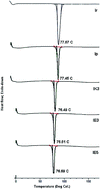Polymer co-processing of ibuprofen through compaction for improved oral absorption
Abstract
Improving oral absorption remains a major challenge for the biopharmaceutical industries aiming at introducing newer drugs or prolonging product life cycle. Most of the strategies adopted to improve oral bioavailability for poorly soluble drugs employ hazardous solvents. The purpose of this study was to improve the oral absorption of ibuprofen adopting a green pharmaceutical approach without using hazardous solvents. In this study commonly used cellulosic polymers were exploited to improve the absorption of the dissolution-rate-limited drug ibuprofen through a simple co-processing through compaction method. The un-processed, processed and co-processed ibuprofen samples were subjected to physicochemical characterization by Fourier transform infrared spectroscopy (FT IR), differential scanning calorimetry (DSC) and Powder X-ray Diffraction (PXRD). Further, in vitro dissolution studies and ex vivo intestinal absorption studies were also conducted. FT IR, DSC and PXRD revealed no molecular interaction of ibuprofen with the studied co-processing excipients and/or method. The co-processed ibuprofen samples exhibited significant improvement in dissolution (unprocessed samples released 56.23 ± 2.92% ibuprofen whereas processed samples released up to 89.67 ± 2.88%). Similar improvement in intestinal permeation was also observed. The in vitro dissolution and ex vivo permeation data showed a higher degree of correlation (r > 0.9). The method adopted in this study may provide a lower cost, quicker, readily scalable alternative for formulating poorly water-soluble drugs.


 Please wait while we load your content...
Please wait while we load your content...